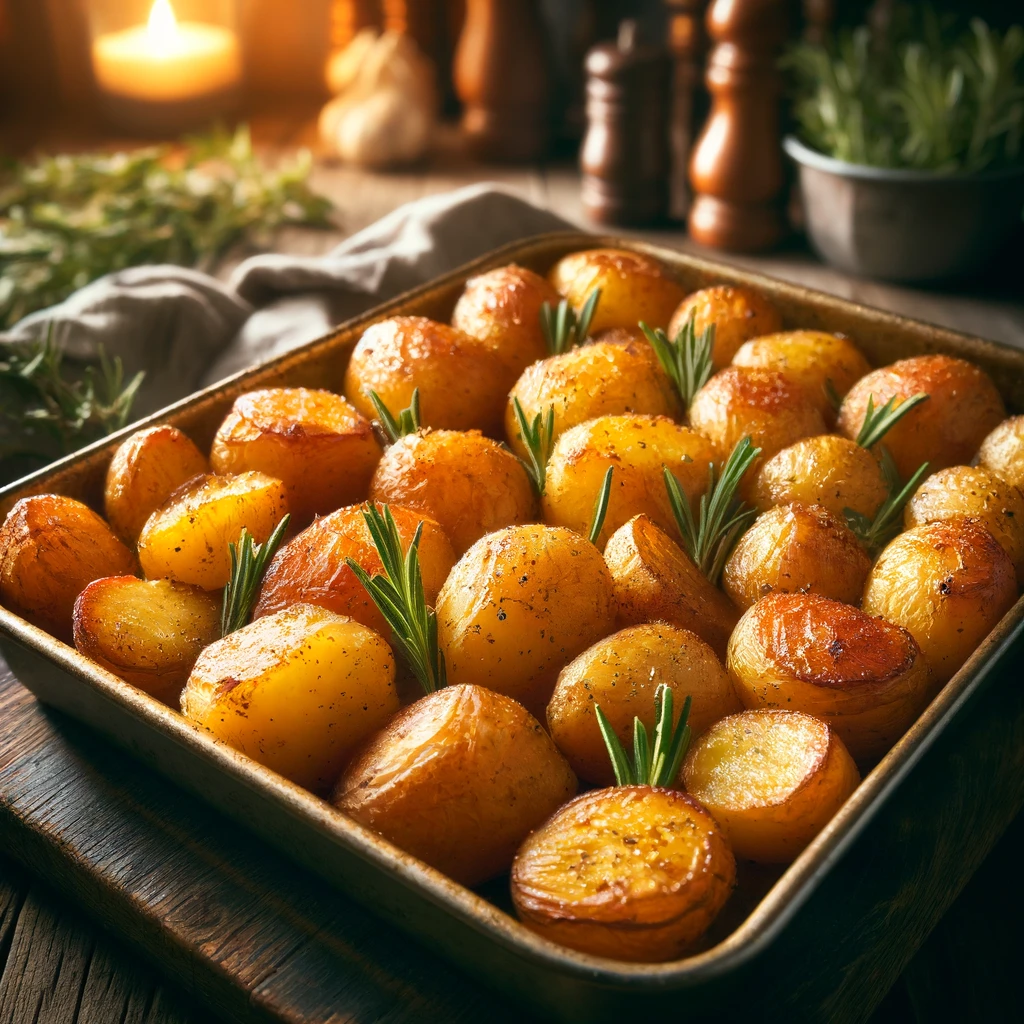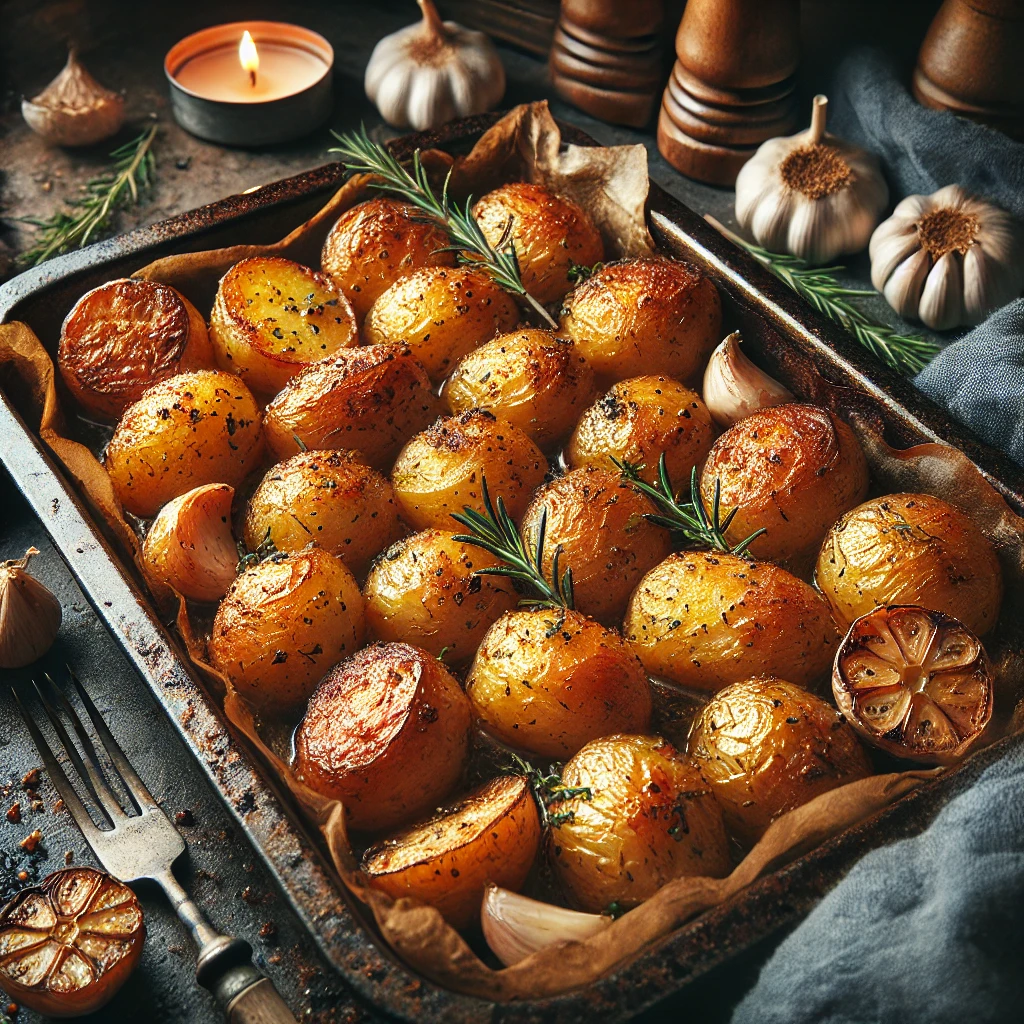
I love roast potatoes. They are a very rare treat for me, as I live the ketogenic lifestyle for most of the year. So when I make them, they have to be perfect. But roasting potatoes might seem like a straightforward task – cut, season, roast, done. But achieving that elusive, golden-brown crispiness on the outside while keeping the inside fluffy is an art. Whether you’re preparing a simple weeknight meal or the perfect holiday side dish, mastering the roasted potato is a culinary triumph. Here’s the foolproof guide to ensure your roast potatoes are irresistibly crispy every time.
The Science Behind Crispy Potatoes
Achieving perfectly crispy potatoes is as much about science as it is about culinary skill. The key lies in understanding the behavior of starch, water, and heat, which work together to create the iconic contrast of a crunchy exterior and a fluffy interior. Let’s break down the process in detail to uncover the secrets behind crispy success.
Starch: The Crispy Backbone
Potatoes are primarily composed of starch, a carbohydrate that plays a vital role in texture. When heated, starch molecules absorb water and swell, turning soft and gel-like. In the case of roasted potatoes, this gelatinized starch is essential for creating a smooth and creamy interior.
For the exterior, starch also contributes to crispiness. During roasting, the surface starch dehydrates and undergoes a process called the Maillard reaction, a chemical reaction between amino acids and reducing sugars that produces browning and complex flavors. High-starch potatoes like Russets excel at crisping up because their abundant starch content provides plenty of material for this process.
Water: Friend and Foe
Water content in potatoes is a double-edged sword. While some moisture is needed for the gelatinization of starch, excess water can hinder crispiness. Too much water on the potato’s surface creates steam during roasting, which prevents the formation of a crisp crust and leads to soggy results.
This is why the parboiling step is crucial – it helps remove some of the internal starch and moisture. By simmering the potatoes in water, you soften their edges and allow some of the surface starch to escape. When drained, these rough, starchy edges create the ideal canvas for crisping.
Heat: The Catalyst for Perfection
Temperature is critical in roasting potatoes. The oven needs to be hot enough to evaporate moisture quickly and drive the Maillard reaction. A temperature of 425°F (220°C) is ideal for achieving crispy potatoes. If the temperature is too low, the moisture in the potatoes won’t evaporate fast enough, leading to steaming rather than roasting. Conversely, if the temperature is too high, the outsides may burn before the insides are fully cooked.
The preheating of the baking sheet amplifies the role of heat. When the potatoes hit the hot surface, they begin to sizzle immediately, creating a layer of crusty starch. This instant caramelization locks in the moisture inside while ensuring the exterior becomes golden and crunchy.
Maximizing Surface Area
Surface area is another crucial factor in achieving crispiness. The more surface area exposed to heat, the greater the opportunity for browning and crisping. This is why cutting potatoes into uniform chunks is vital – they should be large enough to maintain a fluffy interior but small enough to maximize surface contact. Roughing up the potatoes after parboiling is an additional step that boosts surface area by creating tiny ridges and crevices that trap fat and heat, enhancing crispiness.
Fats and Oils: The Flavor Enhancers
Fat plays a dual role: it promotes even browning and enhances flavor. Oils with a high smoke point, like olive oil or duck fat, are ideal because they can withstand the high roasting temperature without breaking down. Fat coats the potato’s surface, helping to transfer heat efficiently and ensuring an even, golden crust.
Maillard Reaction and Caramelization
The Maillard reaction and caramelization are the two chemical processes responsible for the golden-brown color and nutty, savory flavors of crispy potatoes. The Maillard reaction requires heat, amino acids, and sugars, while caramelization happens as natural sugars in the potato break down under high heat. These reactions are more intense at higher temperatures, which is why a hot oven and preheated tray are essential.
By understanding the interplay of starch, water, heat, and fat, you can consistently produce roast potatoes that are a triumph of texture and taste. Whether you’re a home cook or a culinary enthusiast, this knowledge will ensure crispy success every time.
Choosing the Right Potato
Not all potatoes are created equal, and selecting the right type makes a significant difference. The best choices are starchy potatoes, like:
| Potato Type | Characteristics | Ideal for Roasting? |
|---|---|---|
| Russet (Idaho) | High starch, low moisture | Excellent |
| Yukon Gold | Medium starch, creamy texture | Great |
| Red Potatoes | Waxy, lower starch, smooth skin | Decent |
Russets deliver the crispiest results, thanks to their high starch content, but Yukon Golds are a close second with their buttery flavor.
The Step-by-Step Process
1. Prep the Potatoes
- Peel or Leave the Skin On?
It’s a matter of preference. Peeling provides more even browning, while leaving the skin on adds texture and nutrients. - Cut for Surface Area:
Dice potatoes into even chunks, ideally about 2-3 inches wide. Larger pieces take longer to crisp, while smaller ones might dry out.
2. Parboil for Success
- Bring a pot of salted water to a boil and add the potatoes. Simmer for 5-7 minutes until the edges start to soften.
- Why parboil? This step removes some surface starch and ensures the centers cook fully without drying out during roasting.
3. Rough Them Up
- Drain the parboiled potatoes, then give them a gentle shake in the colander. This roughens the edges, creating more surface area to crisp in the oven. It’s also VERY IMPORTANT to allow the potatoes to shed all their steam. Don’t continue unless the steam has abated.
4. Season and Coat
- Choose Your Fat: Toss potatoes with a high-smoke-point fat like olive oil, duck fat, or vegetable oil. Lard or tallow works too. Be generous – crispy potatoes need a good coating.
- Season Liberally: Salt is non-negotiable, but you can add garlic powder, smoked paprika, rosemary, or thyme for extra flavor.
5. Preheat Your Baking Sheet
- Place the baking sheet in the oven as it preheats to 425°F (220°C). Starting potatoes on a hot surface jumpstarts the crisping process.
6. Spread and Roast
- Arrange potatoes in a single layer on the hot sheet. Overcrowding leads to steaming rather than roasting, so give them space.
- Roast for 30-40 minutes, flipping halfway through. Keep an eye out for golden-brown edges.
Tips for Next-Level Crispiness
- Double Roast Technique: Roast the potatoes at a high temperature first (425°F/220°C) and then reduce to 375°F (190°C) for the final 10 minutes. This technique ensures full caramelization.
- Dust with Flour or Semolina: Before roasting, lightly dust the potatoes with flour or semolina. It adds an extra layer of crunch.
- Add Aromatics Late: Fresh garlic, herbs, or Parmesan cheese can burn if added too early. Toss them in during the last 10 minutes.
Troubleshooting Common Mistakes
| Problem | Likely Cause | Solution |
|---|---|---|
| Soggy potatoes | Too much steam. Overcrowding on the baking sheet | Allow all steam to abate before putting on the baking sheet. Use two sheets or roast in batches. |
| Not crispy enough | Low oven temperature or too much oil | Raise the temperature and reduce oil slightly. |
| Burnt outside, raw inside | Skipped parboiling or uneven cuts | Always parboil and cut evenly. |
Elevating the Flavor Game

Once you’ve mastered the basic technique, try these variations for a flavor boost:
- Truffle Roast Potatoes: Drizzle with truffle oil before serving.
- Spicy Kick: Add cayenne pepper or chili flakes to your seasoning mix.
- Lemon and Herb: Toss with lemon zest and fresh parsley after roasting.
- Garlic: Throw in garlic cloves in their skin before putting in the oven.
Storing and Reheating
If you have leftovers (a rare event), store them in an airtight container in the fridge for up to three days. Reheat them in a hot oven (375°F/190°C) to restore crispiness. Avoid the microwave – it’ll make them soggy.
The Final Test
How do you know you’ve achieved roasted potato perfection? Listen. Yes, listen. Crispy roast potatoes will sizzle gently when moved. Bite into one – it should crunch audibly before giving way to a soft, fluffy center.
With these tips and tricks, you’re set to conquer the world of roasted potatoes. Whether for a Sunday roast, a holiday feast, or just because you’re craving the ultimate comfort food, crispy potatoes are now firmly within your grasp. Enjoy your crispy success!
For more on potato varieties and their uses, visit Wikipedia’s potato article. For a deeper dive into the science of starch and cooking, check out starch cooking on Wikipedia.

